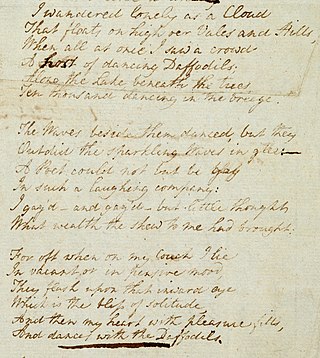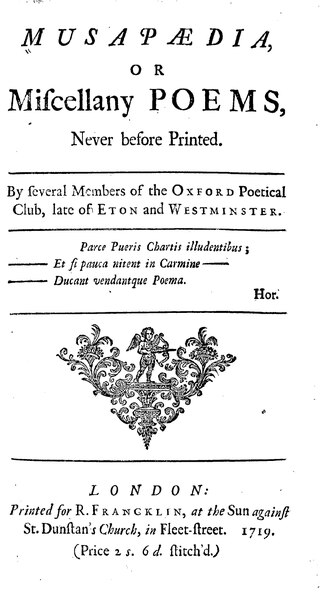
A ballad is a form of verse, often a narrative set to music. Ballads derive from the medieval French chanson balladée or ballade, which were originally "dance songs". Ballads were particularly characteristic of the popular poetry and song of Britain and Ireland from the Late Middle Ages until the 19th century. They were widely used across Europe, and later in Australia, North Africa, North America and South America.

Amelia Opie was an English author who published numerous novels in the Romantic period up to 1828. Opie was also a leading abolitionist in Norwich, England. Hers was the first of 187,000 names presented to the British Parliament on a petition from women to stop slavery.

John Caspar Leyden, M.D., was a Scottish indologist.

Letitia Elizabeth Landon was an English poet and novelist, better known by her initials L.E.L.

William Lisle Bowles was an English priest, poet and critic.

Joseph Ritson was an English antiquary who is well known for editing the first scholarly collection of Robin Hood ballads (1795). After a visit to France in 1791, he became a staunch supporter of the ideals of the French Revolution. He was also an influential vegetarianism activist. He is also known for his collections of English nursery rhymes, such as "Roses Are Red" and "Little Bo-Peep", in Gammer Gurton's Garland or The Nursery Parnassus, published in London by Joseph Johnson.

"I Wandered Lonely as a Cloud" is a lyric poem by William Wordsworth. It is one of his most popular, and was inspired by a forest encounter on 15 April 1802 between he, his younger sister Dorothy and a "long belt" of daffodils. Written in 1804, it was first published in 1807 in Poems, in Two Volumes, and as a revision in 1815.

Endymion is a poem by John Keats first published in 1818 by Taylor and Hessey of Fleet Street in London. John Keats dedicated this poem to the late poet Thomas Chatterton. The poem begins with the line "A thing of beauty is a joy for ever". Endymion is written in rhyming couplets in iambic pentameter. Keats based the poem on the Greek myth of Endymion, the shepherd beloved of the moon goddess Selene. The poem elaborates on the original story and renames Selene "Cynthia".

The Lay of the Last Minstrel (1805) is a narrative poem in six cantos with copious antiquarian notes by Walter Scott. Set in the Scottish Borders in the mid-16th century, it is represented within the work as being sung by a minstrel late in the 1600s.
Nationality words link to articles with information on the nation's poetry or literature.
Nationality words link to articles with information on the nation's poetry or literature.

"Composed upon Westminster Bridge, September 3, 1802" is a Petrarchan sonnet by William Wordsworth describing London and the River Thames, viewed from Westminster Bridge in the early morning. It was first published in the collection Poems, in Two Volumes in 1807.

Anne Bannerman was a Scottish poet. She was part of the Edinburgh literary circle which included John Leyden, Jessie Stewart, Thomas Campbell, and Robert Anderson. Her work was popular in her lifetime and "remains significant for her Gothic ballads, as well as for her innovative sonnet series and her bold original odes."

The sonnet was a popular form of poetry during the Romantic period: William Wordsworth wrote 523, John Keats 67, Samuel Taylor Coleridge 48, and Percy Bysshe Shelley 18. But in the opinion of Lord Byron sonnets were “the most puling, petrifying, stupidly platonic compositions”, at least as a vehicle for love poetry, and he wrote no more than five.

A miscellany is a collection of various pieces of writing by different authors. Meaning a mixture, medley, or assortment, a miscellany can include pieces on many subjects and in a variety of different forms. In contrast to anthologies, whose aim is to give a selective and canonical view of literature, miscellanies were produced for the entertainment of a contemporary audience and so instead emphasise collectiveness and popularity. Laura Mandell and Rita Raley state:
This last distinction is quite often visible in the basic categorical differences between anthologies on the one hand, and all other types of collections on the other, for it is in the one that we read poems of excellence, the "best of English poetry," and it is in the other that we read poems of interest. Out of the differences between a principle of selection and a principle of collection, then, comes a difference in aesthetic value, which is precisely what is at issue in the debates over the "proper" material for inclusion into the canon.

Amelia B. Coppuck Welby was a 19th-century American fugitive poet. In 1837, under the pen-name "Amelia," she contributed a number of poems to the Louisville "Journal," acquiring a reputation as a notable poet. She published in 1844 a small volume of poems, which quickly passed through several editions. It was republished in 1850, in New York City, in enlarged form, with illustrations by Robert Walter Weir. Though many of her poems were on the subject of death, including "The Bereaved", "The Dying Girl", "The Dying Mother", "The First Death of the Household", "The Mournful Heart", and "Sudden Death", she was one of the most popular poets in the South before the Civil War. Amelia Welby died in 1852.

Elizabeth Somerville was a Scottish novelist who wrote primarily for children. She was also a school mistress.
The Mountain Bard (1807), containing 21 poems, was James Hogg's first substantial poetical publication.

Gebir is a long poem by the English writer Walter Savage Landor. The poem was first published anonymously in English in July 1798, before being revised and republished in 1803, in dual, separate Latin and English editions.
Mary Julia Young was a prolific novelist, poet, translator, and biographer, active in the Romantic period, who published the bulk of her works with market-driven publishers James Fletcher Hughes and William Lane of the Minerva Press. She is of particular interest as an example of a professional woman writer in "a market of mass novel production."
![Title page, Anon. [Anne Bannerman], Tales of Superstition and Chivalry (Vernor and Hood, 1802) Bannerman-Tales.jpg](http://upload.wikimedia.org/wikipedia/commons/thumb/f/f4/Bannerman-Tales.jpg/220px-Bannerman-Tales.jpg)















